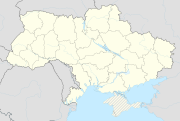Vyshnytsia
| Vyshnytsia | ||
| Вижниця | ||

|
|
|
| Basic data | ||
|---|---|---|
| Oblast : | Chernivtsi Oblast | |
| Rajon : | Vyshnytsia district | |
| Height : | 356 m | |
| Area : | Information is missing | |
| Residents : | 4,580 (2007) | |
| Postcodes : | 59200 | |
| Area code : | +380 3730 | |
| Geographic location : | 48 ° 15 ' N , 25 ° 11' E | |
| KOATUU : | 7320510100 | |
| Administrative structure : | 1 city | |
| Mayor : | Volodymyr Pylypyuk | |
| Address: | вул. Українська 34 59200 м. Вижниця |
|
| Statistical information | ||
|
|
||
Vyzhnytsia ( Ukrainian Вижниця ; Russian Вижница Wischniza , German Wiżnitz or Wischnitz , Romanian Vijniţa or Vişniţa , polish Wyżnica ) is a Rajonshauptstadt in the Ukrainian oblast Tscherniwzi .
geography
Vyshnytsia is located on the right bank of the Cheremosh , about 54 km west of Chernivtsi . On the opposite bank of the Cheremosh is the urban-type settlement of Kuty .
history
The city was probably mentioned as early as 1158, the first unequivocal mention comes in 1501 in a Moldavian chronicle. From 1514 to 1574 the place was occupied by the Turks, after which it belonged to the Principality of Moldova until 1774 . From 1774 to 1918 he was part of the Austrian Empire (from 1849 part of the crown land of Bukovina ).
At the end of the 18th century, forest management was an important economic factor in the place, in 1855 the market town at that time was appointed the seat of a district administration. The opening of the Nepolokoutz – Wiznitz local railway of the New Bukowina Local Railway Company on July 7, 1898, which had its terminus in town, was important for economic development .
In the summer of 1909 a fire disaster occurred in the village , in which 103 houses burned down.
After the end of the First World War , the place became part of Romania , Storojineț district , and became a border town with Poland . Between 1930 and 1944 there was a combined railway and road bridge made of wood across the then border river Cheremosch to the then Polish sister city of Kuty. After the German attack in 1939 , the Polish government, along with a large number of soldiers and civilians, entered exile at this border crossing . In 1940 Vyshnytsia received city rights. In the course of the annexation of Northern Bukovina on June 28, 1940, it became part of the Ukrainian Soviet Socialist Republic within the Soviet Union . Between 1941 and 1944, the city again belonged to Romania and is now part of Ukraine, which has been independent since 1991.
There was a strong Jewish population in the village , who strongly shaped the history and face of Vyshnytsia. The majority were killed or displaced during World War II. The Hasidic Wischnitz movement was founded in Vyshnytsia .
sons and daughters of the town
- Emil Kläger (1880–1936), journalist and writer
- Isaac Schreyer (1890–1948), writer and translator
- Adolf Dauber (1894–1950), violinist, conductor and composer
- Otto Preminger (1905–1986), film director
- Robert Flinker (1906–1945), writer
- Markus Max Fischer (1909–1962), actor and director
- Josef Burg (1912–2009), writer
- Martin Katz (1919–2013), theater director in Munich, author
Individual evidence
- ^ Bernhard Neuner: Bibliography of the Austrian railways from the beginnings to 1918. Vol. 2. Drews, Vienna 2002, p. 855. ISBN 3-901949-00-3
- ↑ A devastating conflagration in Wiznitz. In: Czernowitzer Taglbatt , July 13, 1909, p. 4 (online at ANNO ). .
- ^ Count Edward Raczynski In Allied London Weidenfeld and Nicolson 1962 Page 39
- ^ Editor Waclaw Jedrzejewicz Poland in the British Parliament 1939–1945 . Volume I. Jozef Pilsudski 1946, page 317.
- ↑ Jewish Claims USA, File No. 58.00 / M, REEL 32, ID # 426, Sept. 12,1942, Vol 1-10

